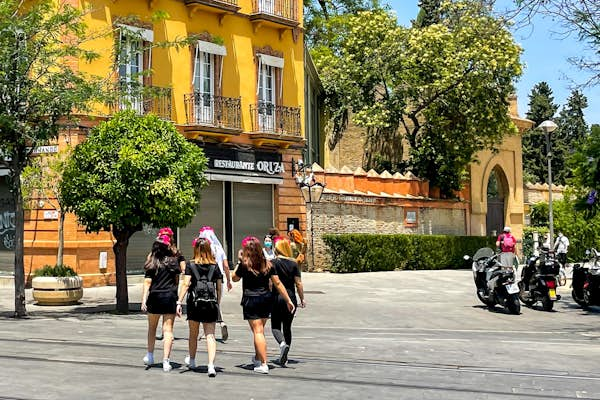How to explore the Baltic States in a week
The Baltic States, comprising Estonia, Latvia & Lithuania, aren’t necessarily the top countries to visit in Europe but each of these countries offer everything that any other European nation does – from charming old towns, castles, museums, hiking activities for […] The post How to explore the Baltic States in a week appeared first on Hopping Feet.
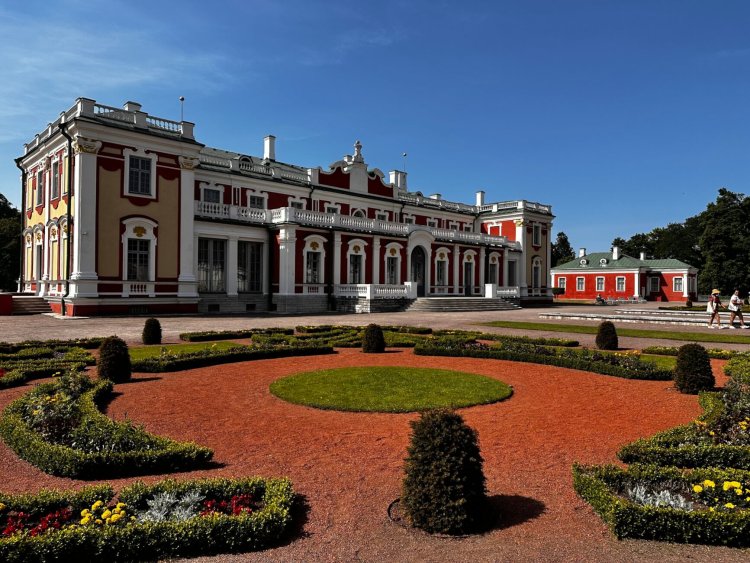
The Baltic States, comprising Estonia, Latvia & Lithuania, aren’t necessarily the top countries to visit in Europe but each of these countries offer everything that any other European nation does – from charming old towns, castles, museums, hiking activities for nature lovers, greenery and landscapes, relaxed vibe, great wine & food, and stunning countryside that provides a more laidback experience for those not looking to be in the cities. The Baltic States share historical and cultural ties, as well as geographical proximity, so it is very easy to travel from one to another by road. The public transportation connectivity is great between the cities, with several operators such as LuxExpress, Ecolines, Infobus, Flixbus, Ollex, etc offering excellent connectivity at an inexpensive price. My favourite in terms of leg space, facilities, comfort, and efficiency was LuxExpress.
Another thing that will make it easier for you to travel within The Baltics is downloading a few tourist-friendly apps even before you travel. Two such apps are:
- MobiMatter: I cannot stress enough how amazing this turned out for us. It’s an eSim app that allows you to buy an esim for your phone which is valid throughout Europe. This means that firstly, you don’t need to buy a physical sim once you arrive in the country. Secondly, the sim works throughout all the European countries seamlessly. Thirdly, the prices are very reasonable. We got an eSim for $13 with 10GB data valid for 30 days. You simply need to download the app, choose your destination(s), choose your package according to your usage preference, and activate the eSim!
- Bolt: This is the Uber of Baltics and is very reasonably priced, convenient, and easy to use. While we preferred to walk around, some destinations are a bit further away, and I wasn’t very comfortable using the eBikes. However, even if you wish to use the eBikes, Bolt is the perfect app that will let you find the closest bikes and unlock to use them while you’re in the city. For others, like me, Bolt was perfect to book taxis when tired or when travelling long distances.
While you can easily spend more time, 1 week is enough for seeing the highlights in The Baltics, along with a few journeys into the countryside to take a break from the hustle & bustle. As usual, my itineraries are action-packed, allowing one to cover the most in a short period of time. Here are my recommendations on how to explore The Baltic States in 1 week.
2 days in Tallinn, Estonia
Tallinn has one of the best connectivity with international airlines out of the 3 countries which is why we flew into Estonia at the beginning our journey while exploring The Baltic States in 1 week. Tallinn also happens to be the most popular city amongst them all. We spent 2 beautiful days exploring Tallinn and the surrounding areas – sparing the second day to immerse ourselves into the Estonian forests.
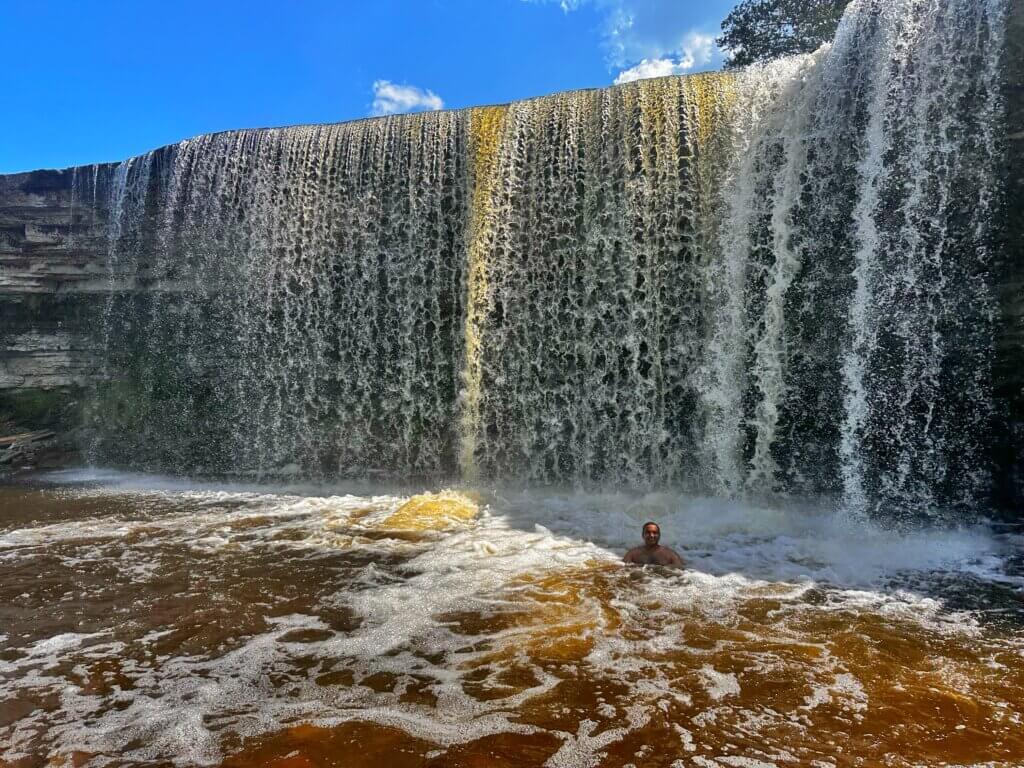
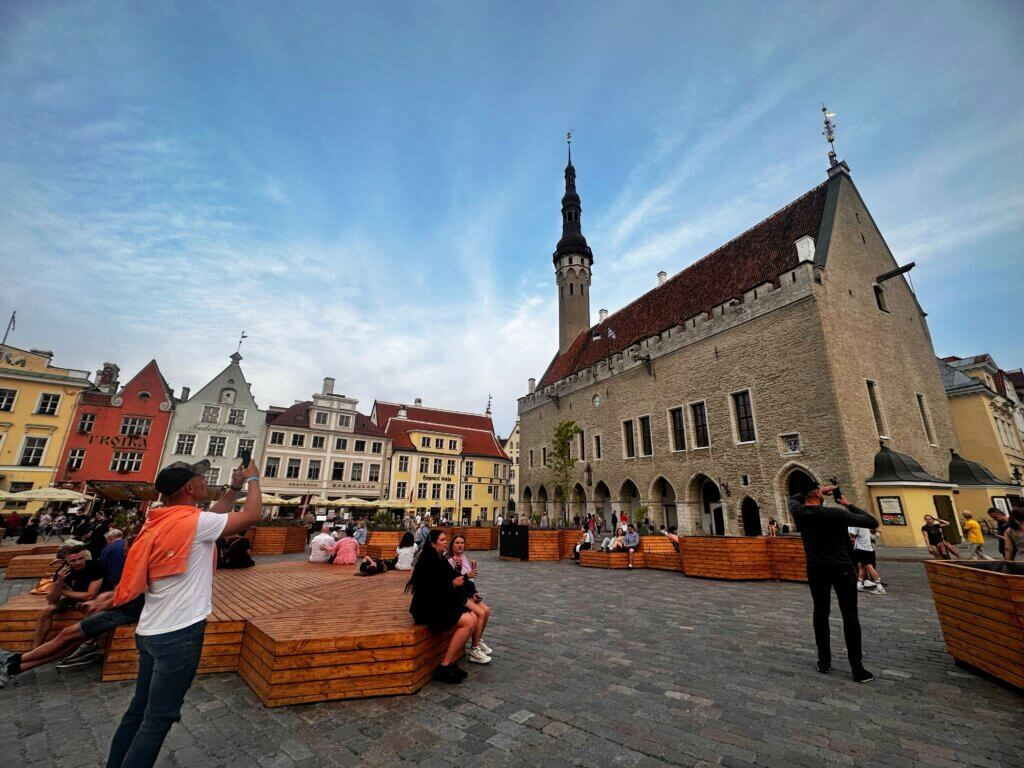
Click here to read about my itinerary for 2 days in Tallinn, Estonia.
2 days in Riga, Latvia
From Tallinn, we took the LuxExpress bus to Riga in Latvia, which was about 4.5 hours by road. You can even choose to rent a car for this itinerary, but we always find it expensive to pick a car in one city and return in another due to the 1-way fee that is charged. Also, since these countries have excellent public transportation & facilities, we decided to skip renting a car, which is our usual mode of transportation on most of our trips. Day 1 in Riga: Riga Old Town
While Tallinn’s old town was charming & cosy, Riga’s old town was grand & impressive! Designated as a UNESCO World Heritage site, with its narrow cobblestone streets, medieval architecture, and iconic landmarks, the best place to start exploring is The Town Hall Square or Rathausplatz, home to some key destinations such as the House of the Blackheads, St. Peter's Church, and Riga Cathedral. One thing you’ll notice in Riga is the number of churches & cathedrals, there’s one in almost every corner!
The Riga Cathedral is a stunning example of Gothic architecture and is one of the largest medieval churches in the Baltic States, holding significant historical and religious importance. The interior of Riga Cathedral is equally impressive, so I recommend buying the ticket to go inside. The cathedral's chapels contain numerous historical artifacts, religious artworks, and tombs of notable figures from Latvia's history.
St. Peter's Church is another prominent and historically significant church in Riga. Climb to the observation deck on top of the tower to enjoy breathtaking views of the Old Town. Finally, visit The House of the Blackheads which was originally constructed in the 14th century as a meeting place and residence for the Brotherhood of the Blackheads, a guild of unmarried merchants, shipowners, and other professionals in Riga. Not only is the building's architecture a fine example of Dutch Renaissance style, the museum inside is a great way to learn about the history of the building, its complete destruction during WW II & subsequent reconstruction, and the Brotherhood of the Blackheads.
To enjoy some tranquillity, take a stroll in The Riga Esplanade, a prominent park located in the heart of the city. The park’s well-manicured lawns, tree-lined pathways, flowerbeds, and benches, make it a serene and inviting atmosphere both for people-watching and relaxing. Also, it is located next to Riga Nativity of Christ Orthodox Cathedral, the largest orthodox cathedral in the city, with an interesting and iconic architecture that stands out from most other buildings in its vicinity.
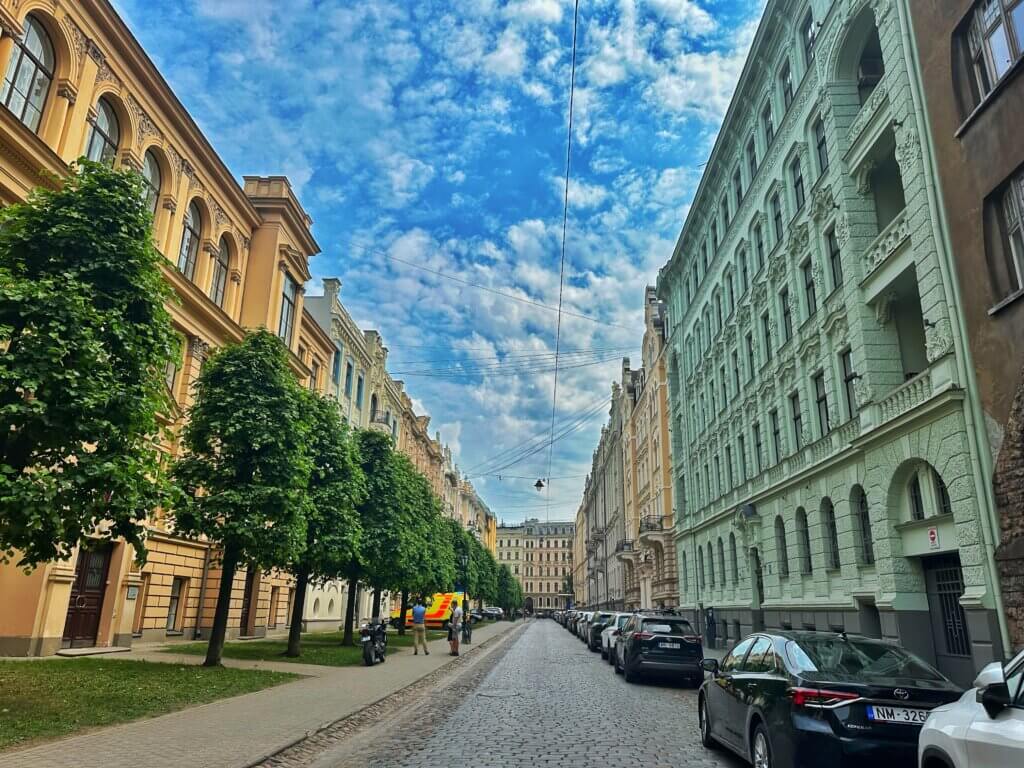
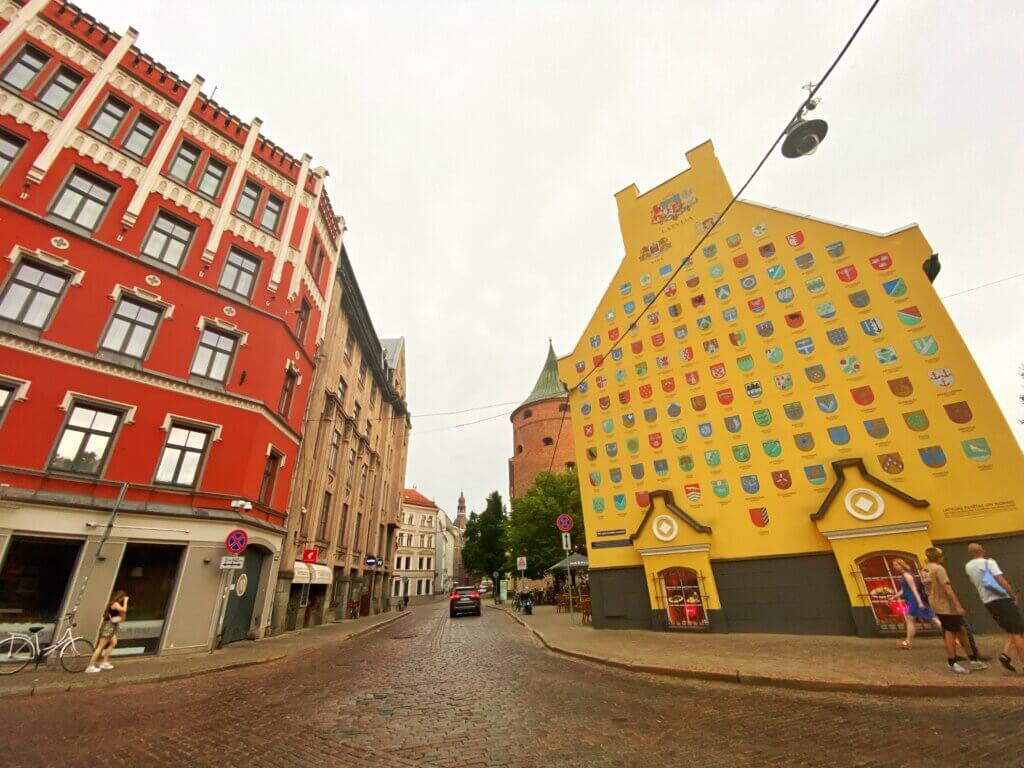
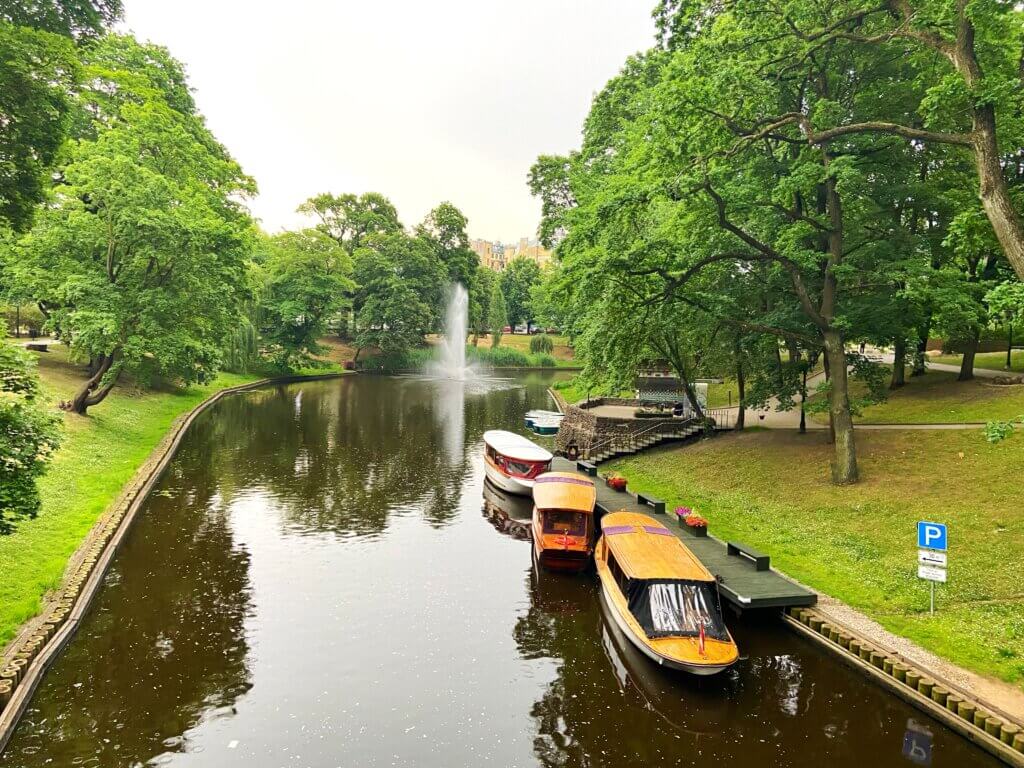
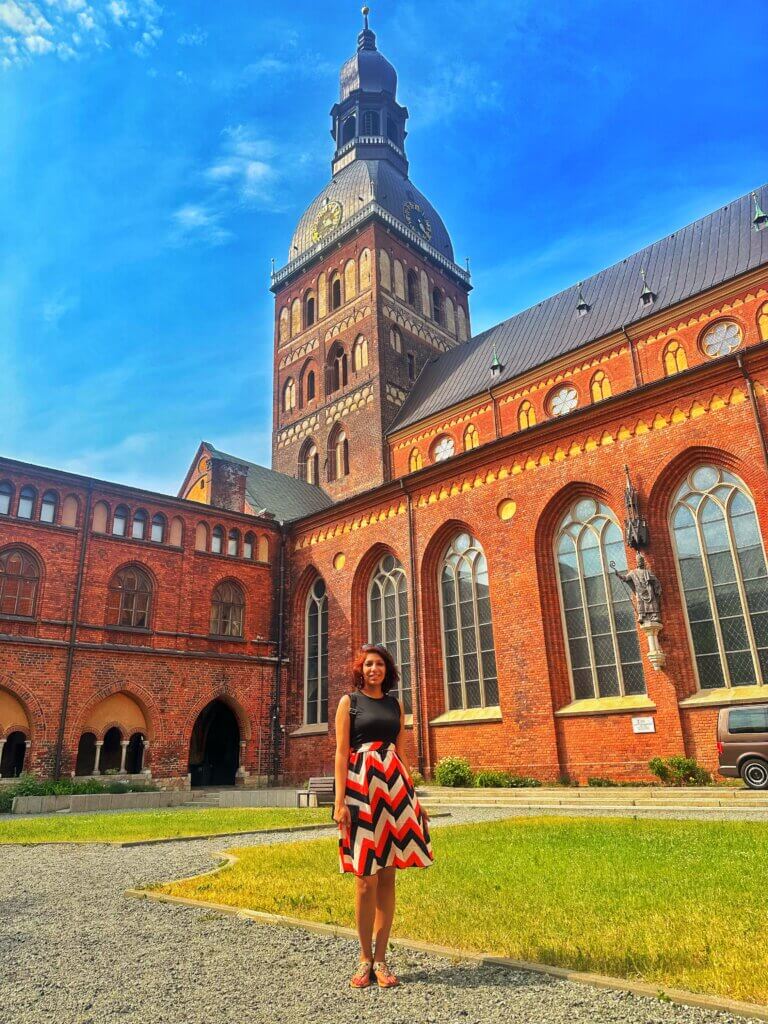
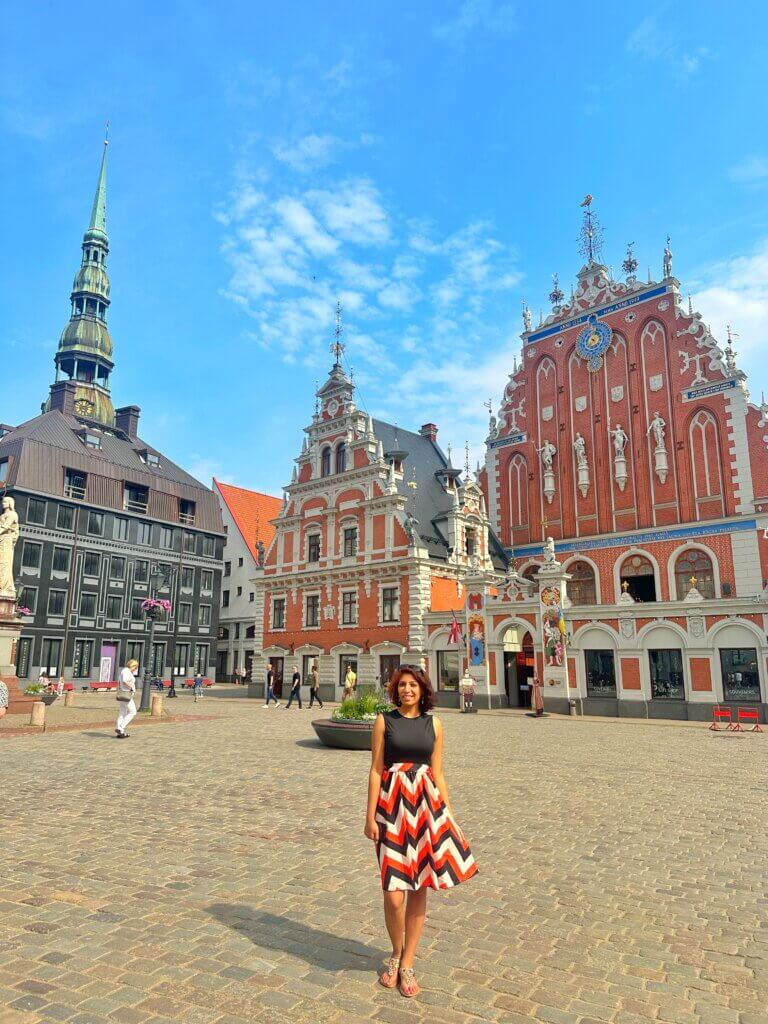
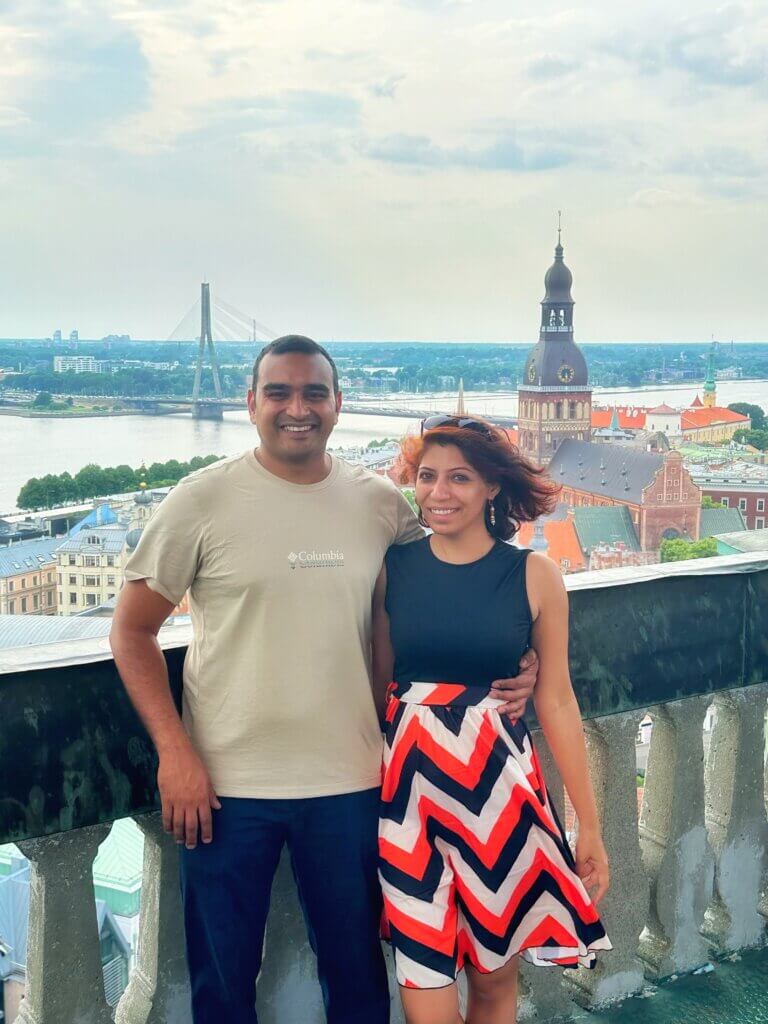
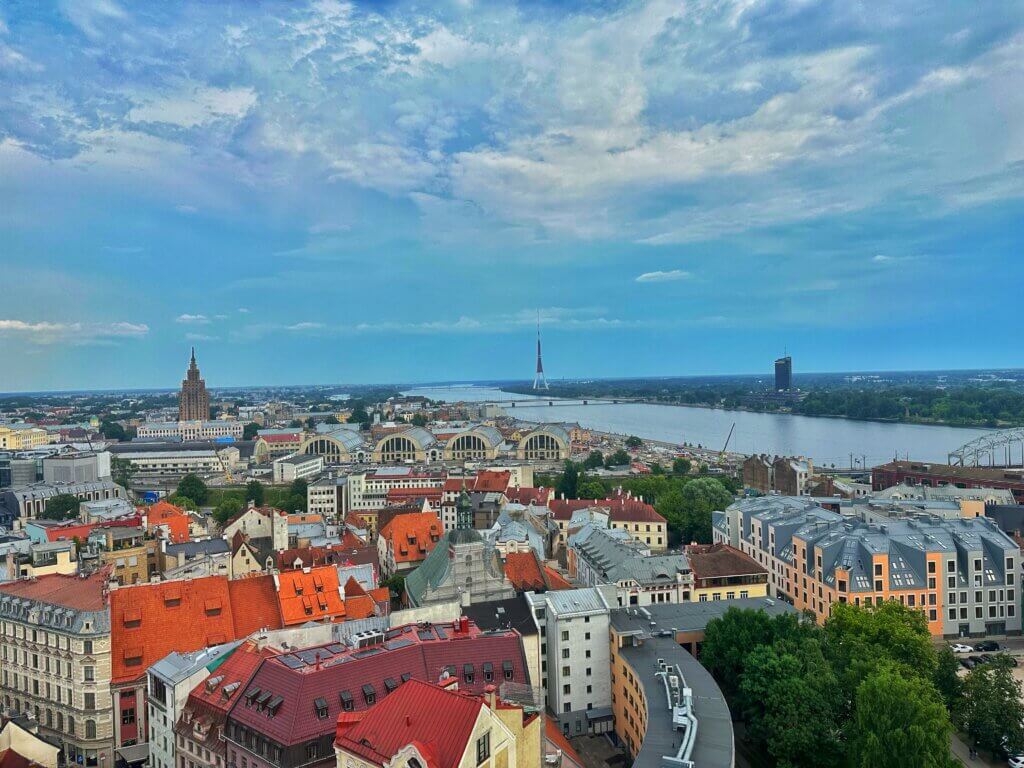
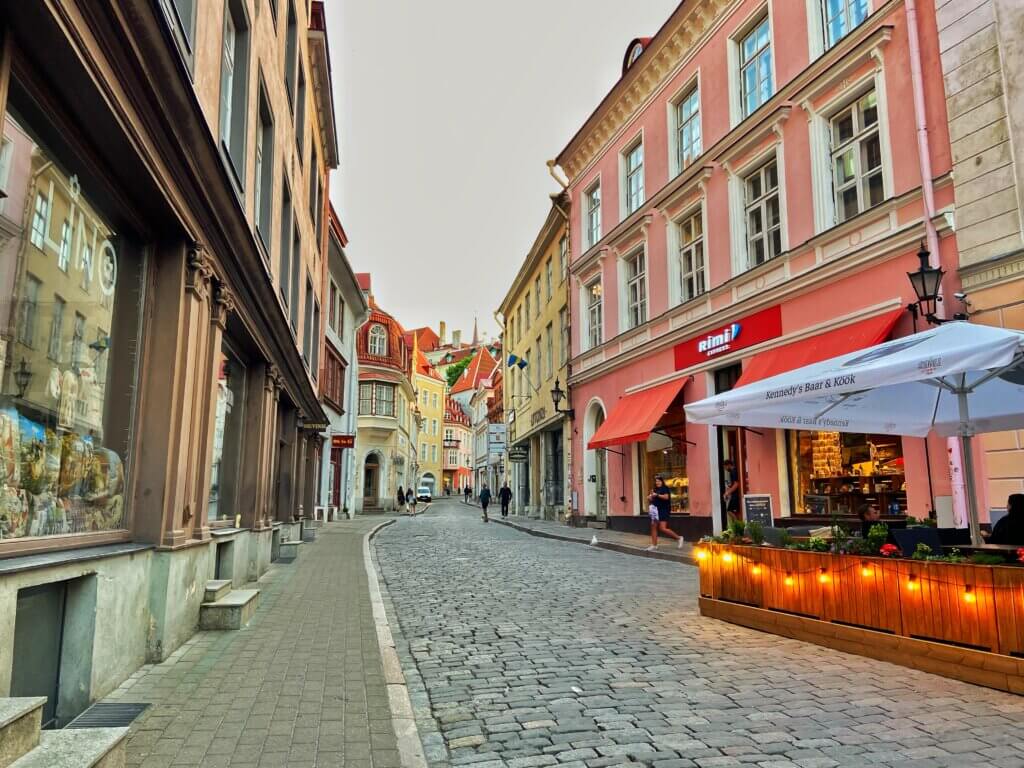
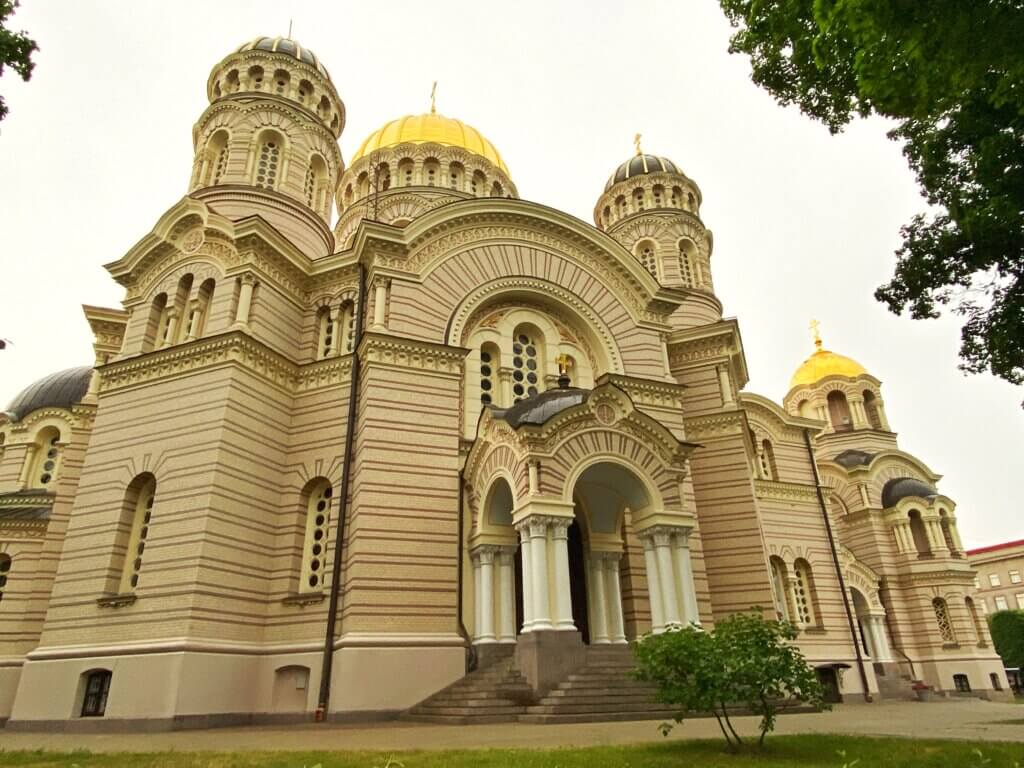
From here, walk across the canal to the Freedom Monument, a symbol of Latvia's independence, national pride, and the country's struggle for freedom and self-determination. This area is a pedestrian street, offering instagrammable areas with a ‘RIGA’ installation & several cafes and bars with an great vibe and amazing nightlife.
Lastly, explore the Art Nouveau architecture along Alberta Street and Elizabetes Street to see some of the most stunning examples of this architectural style in the city. The facades of the buildings on these streets are adorned with intricate sculptures, ornate balconies, and decorative motifs, which are characteristic of the Art Nouveau style. The beautifully crafted facades, elaborate decorative elements, and sculptural ornamentation reflect the opulence and creative spirit of the Art Nouveau movement, making these areas an architecture lovers’ delight to explore!
Recommended place to stay in Riga Old Town: Hotel Valdemars Riga managed by Accor Day 2 in Riga: Day trip to Sigulda
While many people choose to go to Jūrmala, a popular resort town along the Baltic Sea coast which isn’t too far from Riga, to enjoy a relaxing day by the sea, we decided to head in the other direction to a town called Sigulda, as we wanted to head into the greenery and enjoy some nature walks. A picturesque town located in the Gauja River Valley, Sigulda is often referred to as the "Switzerland of Latvia" due to its stunning landscapes and hilly terrain. While you can rent a car and drive about an hour from Riga to Sigulda, we took a bus which was equally easily available.
We started our exploration from the most popular place to visit in Sigulda – the Sigulda Castle complex which has the Castle of the Lavonia Order (told castle ruins) and Sigulda New Castle. The old castle dates to the 13th century and was once a residence for the Livonian Order. The castle was originally designed as a fortified stone castle with defensive walls and towers. Over the centuries, it underwent various renovations and expansions. The castle is strategically located on a hilltop overlooking the Gauja River Valley, offering commanding views of the surrounding landscape.
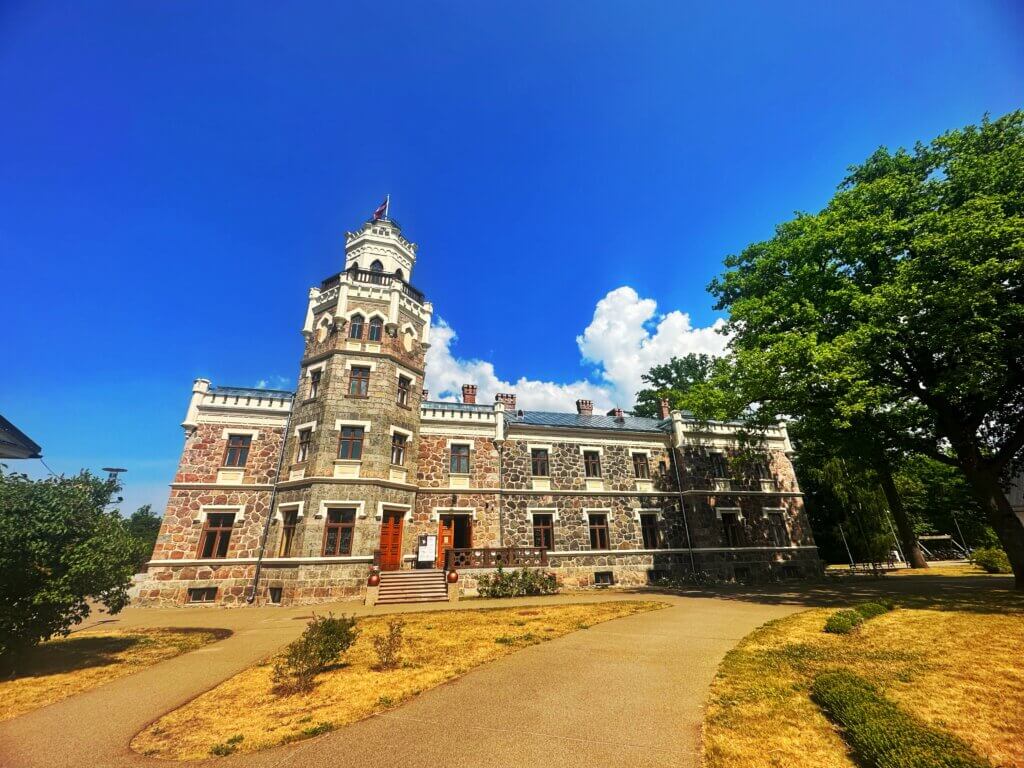
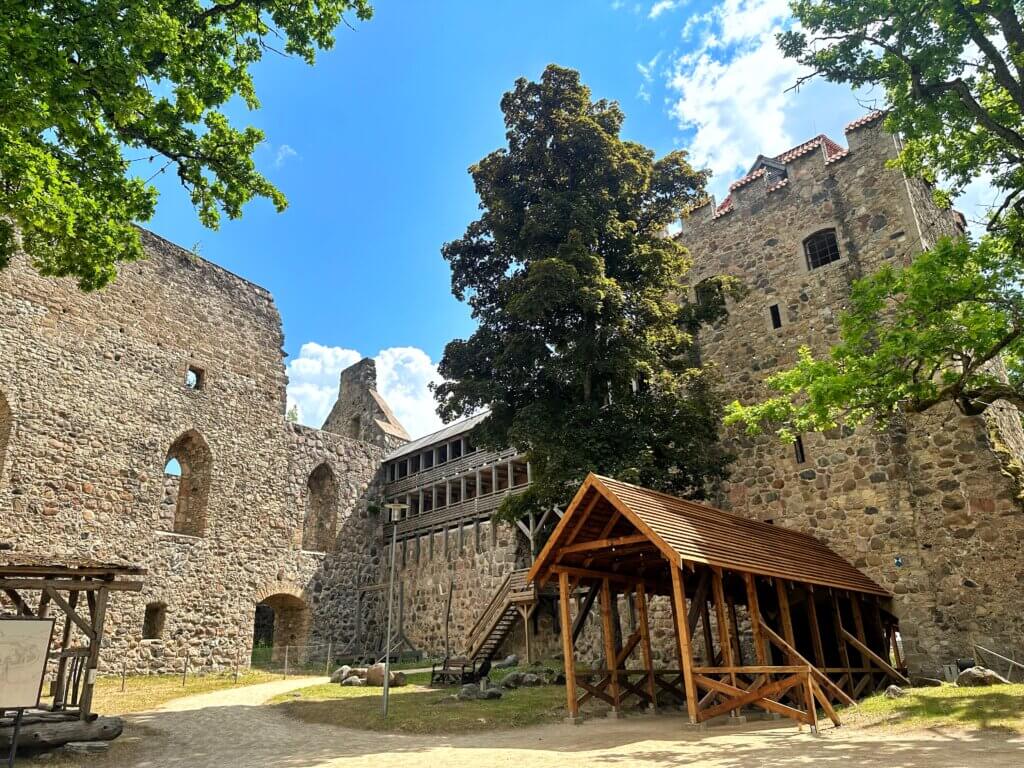

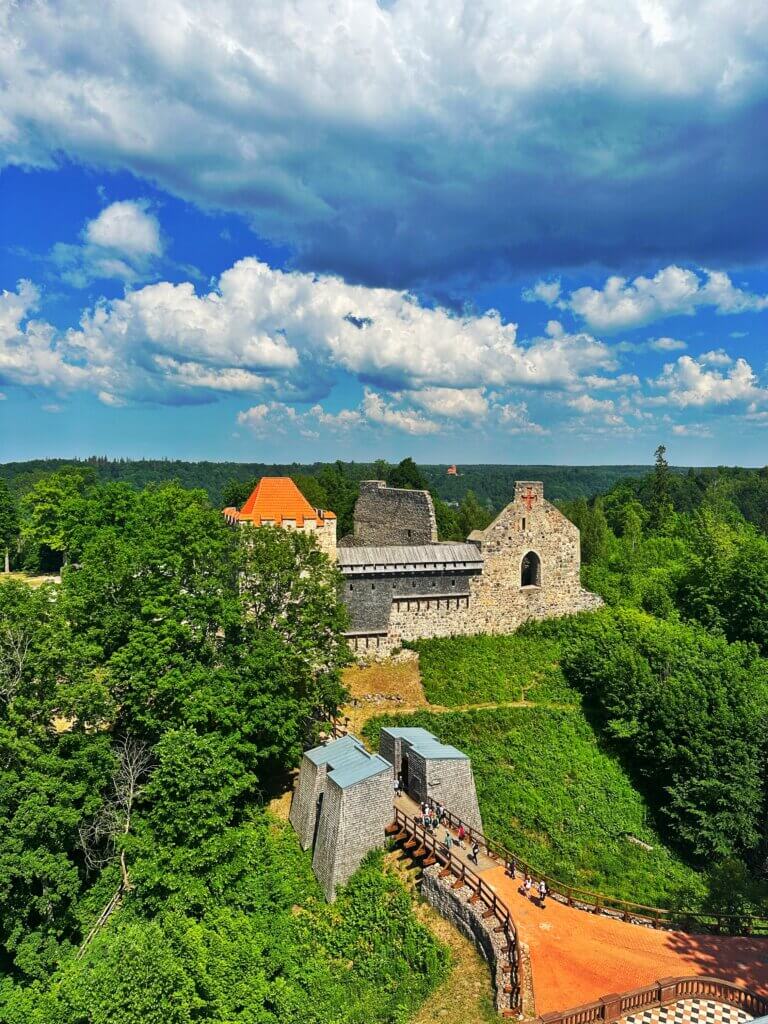
From here, a 10-minute walk will bring you to the Sigulda cable car station from where you can take a scenic cable car journey across the Gauja River towards Krimulda, with breathtaking views and a unique perspective of the surrounding landscape. Once you arrive in Krimulda, visit Krimulda Castle & Manor. The manor was closed due to a wedding when we visited but we decided to sit outside in the cosy local restaurant to enjoy some local wine while we were in the area. The Krimulda Castle today is mostly just ruins of what was once a fortified stone castle with defensive walls, towers, and living quarters. It was strategically located on a hilltop overlooking the Gauja River Valley, providing an advantageous position for defense.

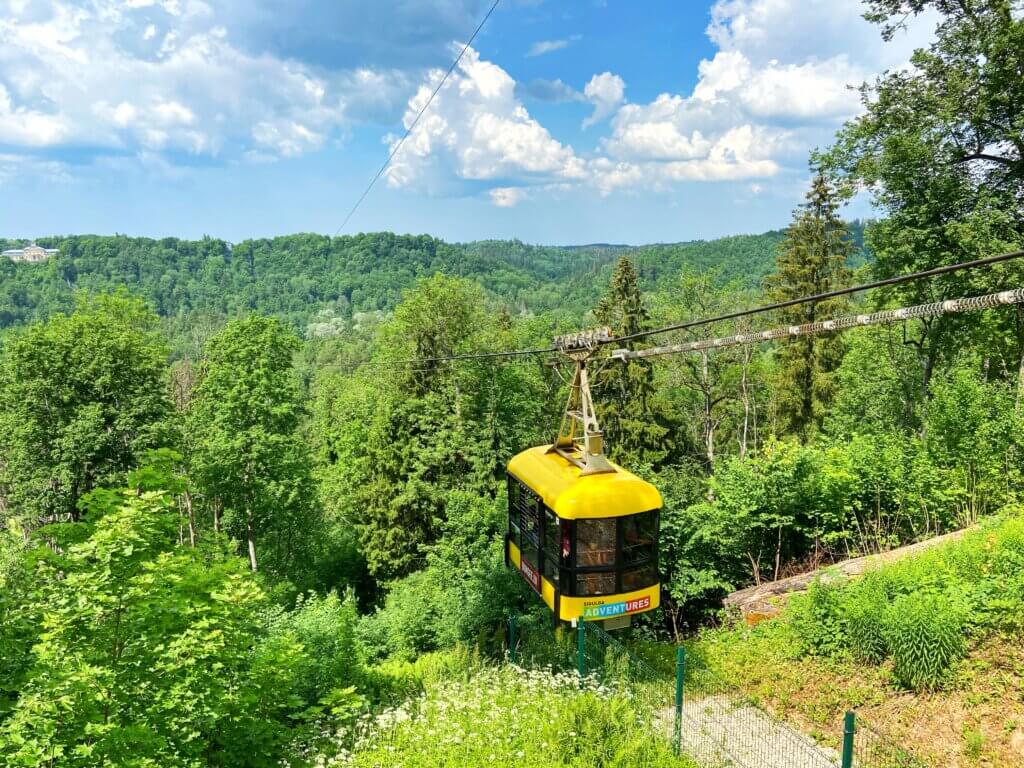
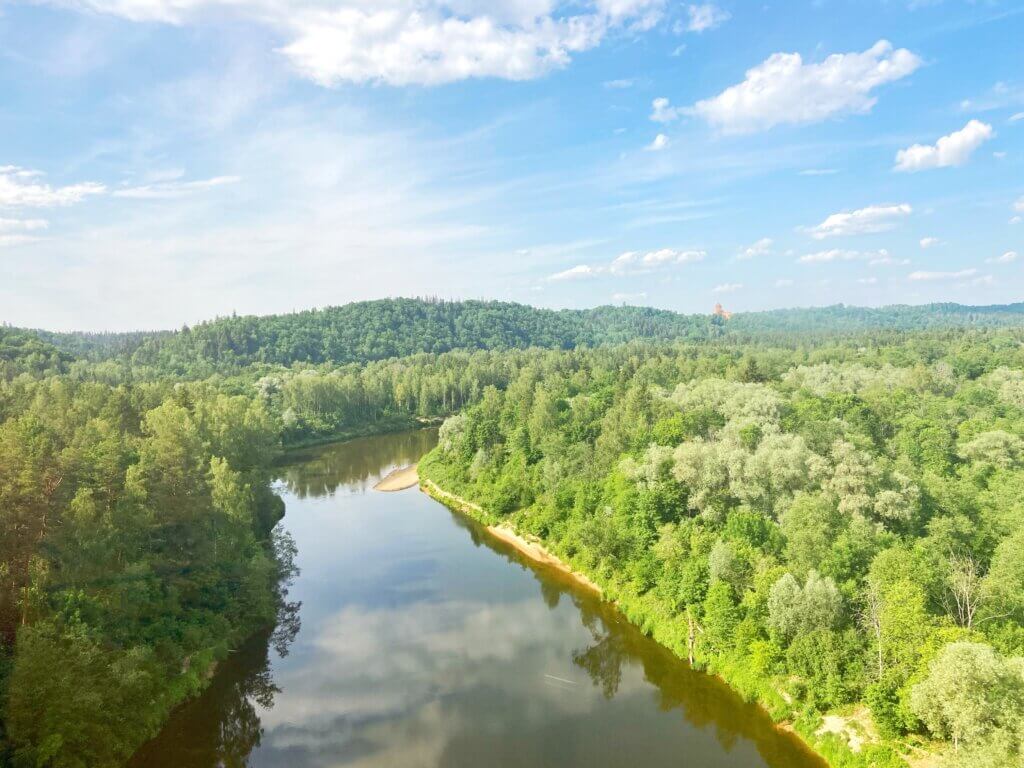
There is a very nice walking trail from Krimulda castle, via Gutmanis Cave, the widest and highest cave in the Baltics, shrouded in local folklore and legends, believed to have healing properties. The walls of the cave are adorned with inscriptions and carvings left by visitors throughout the centuries. You will eventually arrive at Turaida Castle, another one of the most iconic landmarks in Sigulda. This medieval castle, dating back to the 13th century, is perched on a hilltop and offers fantastic views of the surrounding landscape. You can explore the castle's towers, walls, and exhibition halls to learn about its rich history.
Be prepared to walk through some hilly terrain and greenery. While the hike isn’t difficult, it can be very long, so good shoes are highly recommended. Alternatively, if you don’t wish to walk, then you can choose to take a bus from Krimulda cable car station to Turaida Castle (or back). However, the cave can only be visited on foot. Once you’ve explored this area, take the cable car back to Sigulda.
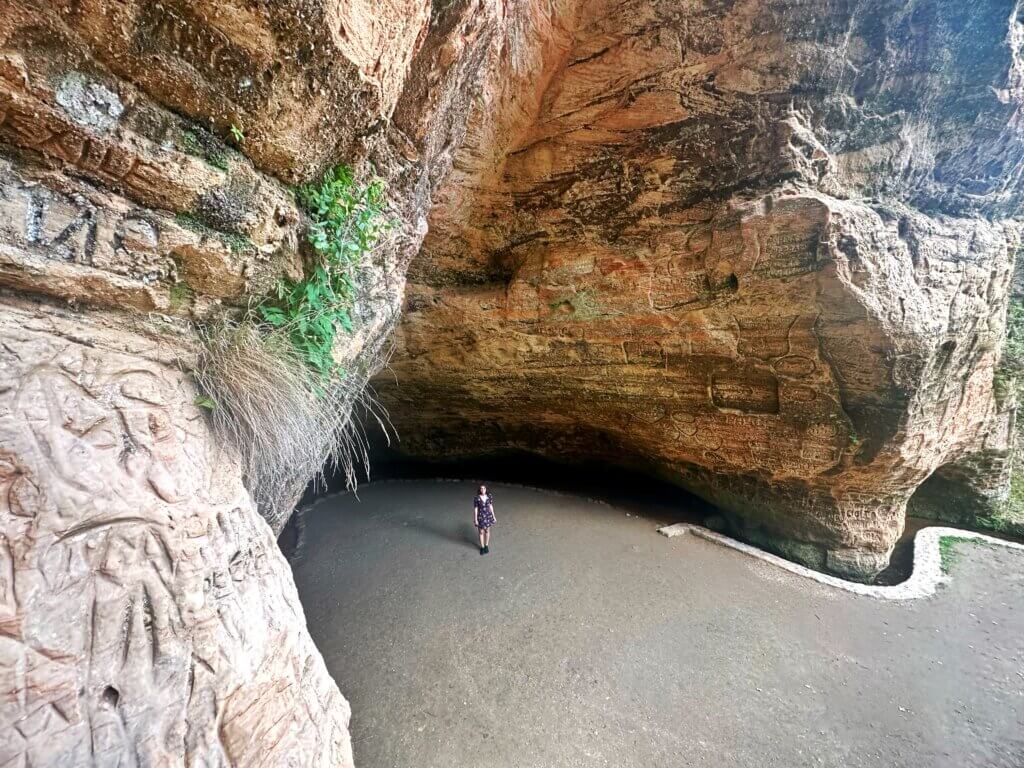
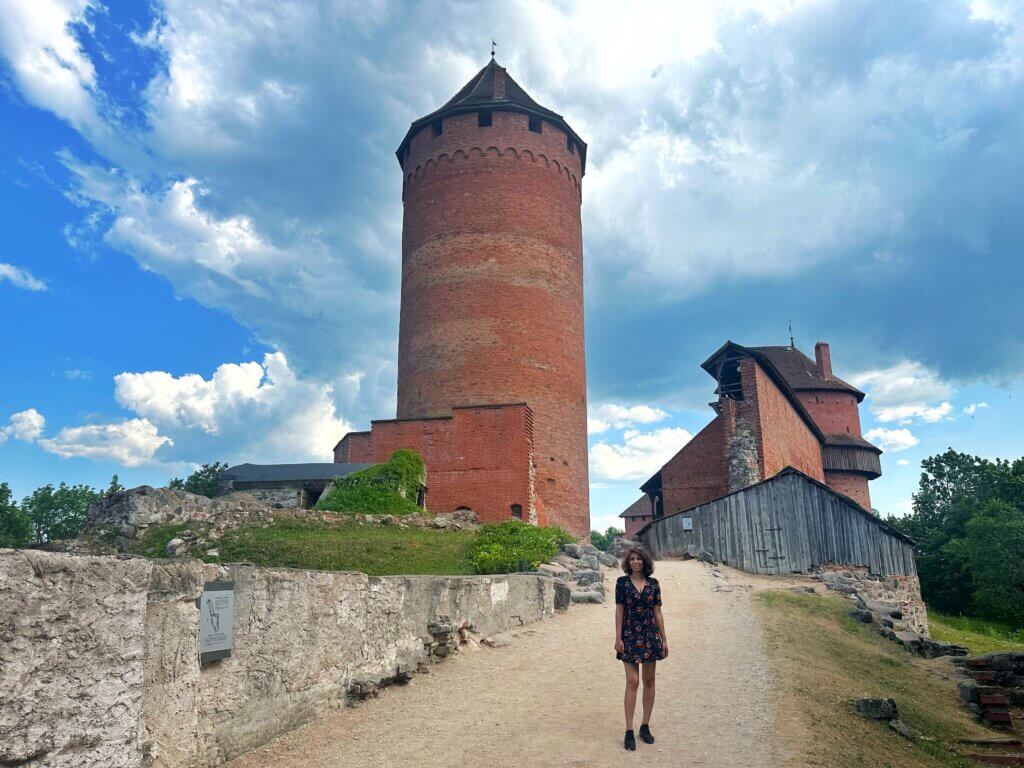
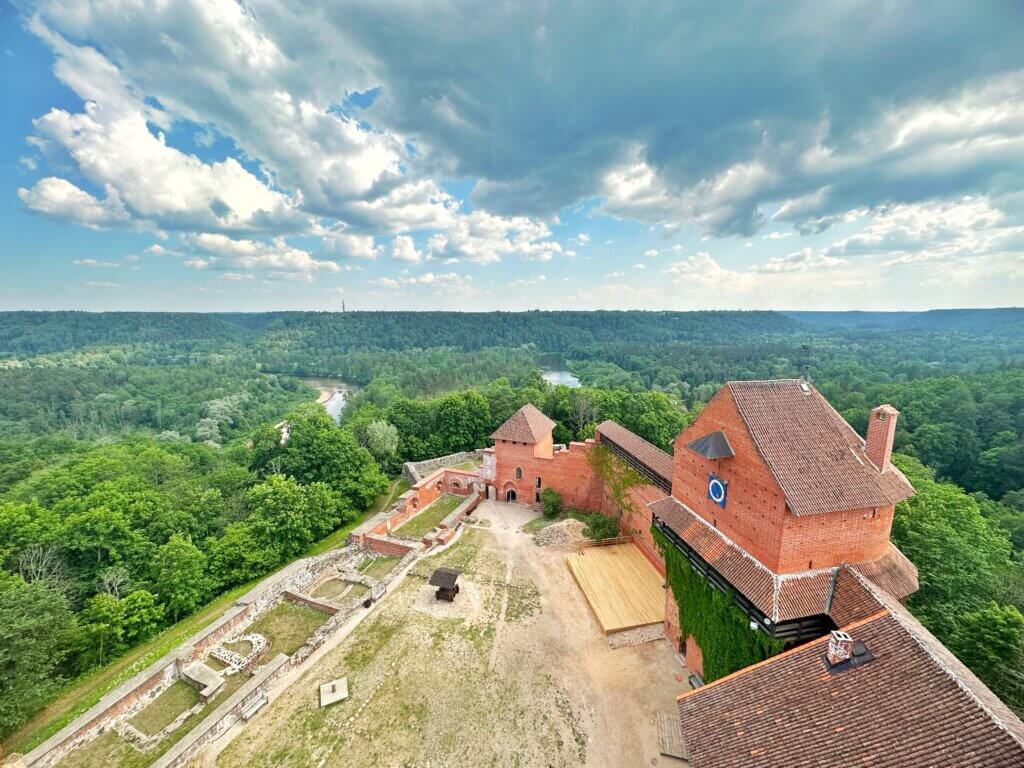
If you’re visiting Sigulda in the winter or summer months and have a huge appetite for adventure and adrenaline pumping activities, visit the Sigulda Bobsleigh Track, where you can experience a bobsleigh ride on a professional track. Unfortunately, during the shoulder spring & autumn months, the track is closed for maintenance, so we missed it. However, when we saw some YouTube videos of the experience, we were so upset to have missed it because it looked absolutely amazing!
Lastly, if time allows, visit the Zilver winery, where you can taste some fruity local wines of Latvia and buy them as souvenirs to take home with you. Most Latvian wines are made from berries rather than grapes so its not uncommon to find flavors such as black current, red currant, apple, rhubarb, etc. Latvian wines aren’t necessarily popular, but their flavours are unique & quite interesting so give it a shot!
At the end of the evening, return to Riga.
2 days in Klaipeda, Lithuania
From Riga, we took a bus to Klaipeda in Lithuania, which is a 4.5-hour journey. While Klaipeda is a more popular stop for cruises, we decided to visit there because I had read a lot about the Curonian Spit which is close to Klaipeda. While in the bus from Riga, many locals seemed surprised with our choice to visit this laidback, small town and asked us about the reason for our decision to visit such a ‘boring place’. After spending 2 days there, I understand why they felt the way they did – when compared to larger cities such as Riga, Tallinn and Vilnius, Klaipeda doesn’t have a lot to see and do. Having said that, it’s still a quiet, serene, cozy, and interesting town and I do not regret our decision of going there. Day 1: Klaipeda Old Town
Klaipeda is small and totally walkable. The Old Town begins and ends even before you know it! Klaipėda has a rich maritime history, and its location on the Baltic Sea has made it a significant port city for centuries. At the center of the Old Town, you will find the city's most famous landmark, the "Annchen von Tharau" sculpture, which represents a fictional character from a popular 17th-century German poem. Several restaurants and cafes on both sides of the canal offer a great vibe, drinks and food. The Friedrich Passage, a historic building complex that has been transformed into a shopping and entertainment centre, is yet another interesting place to explore as it offers a blend of history, shopping, dining, and cultural experiences.
End your day with drinks and dinner at the famous Meridianas, a restaurant on a docked sailing ship in the heart of the Old Town. While it might seem like a very cliché thing to do in Klaipeda, I personally liked the food and the ambience in this restaurant.

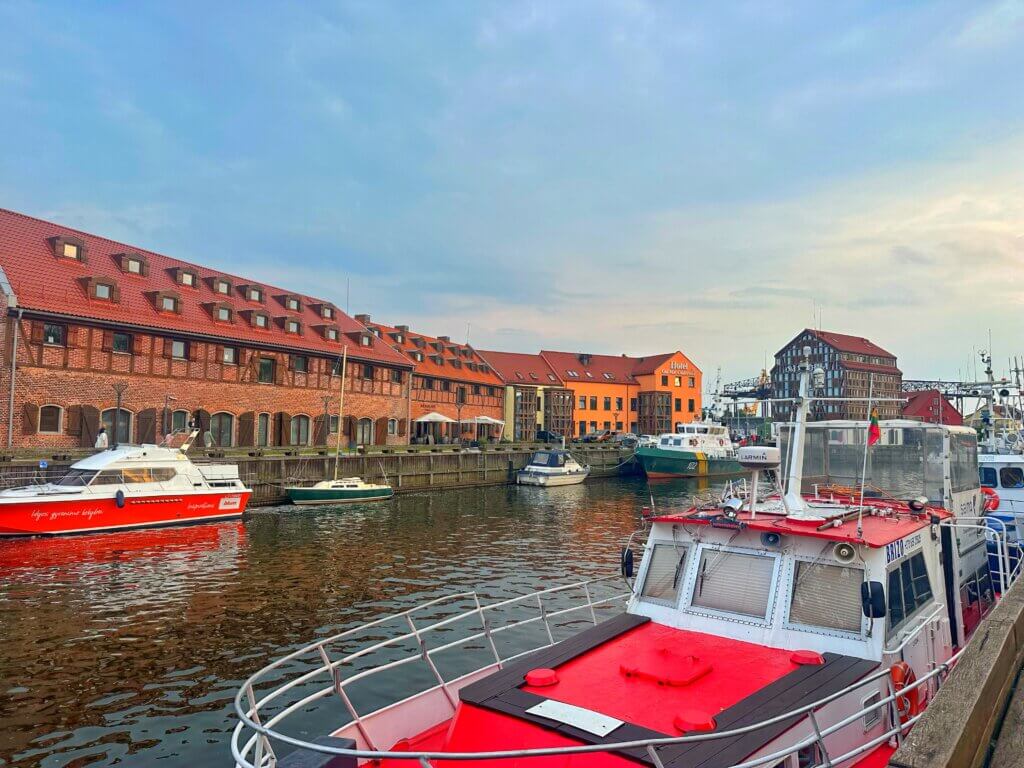
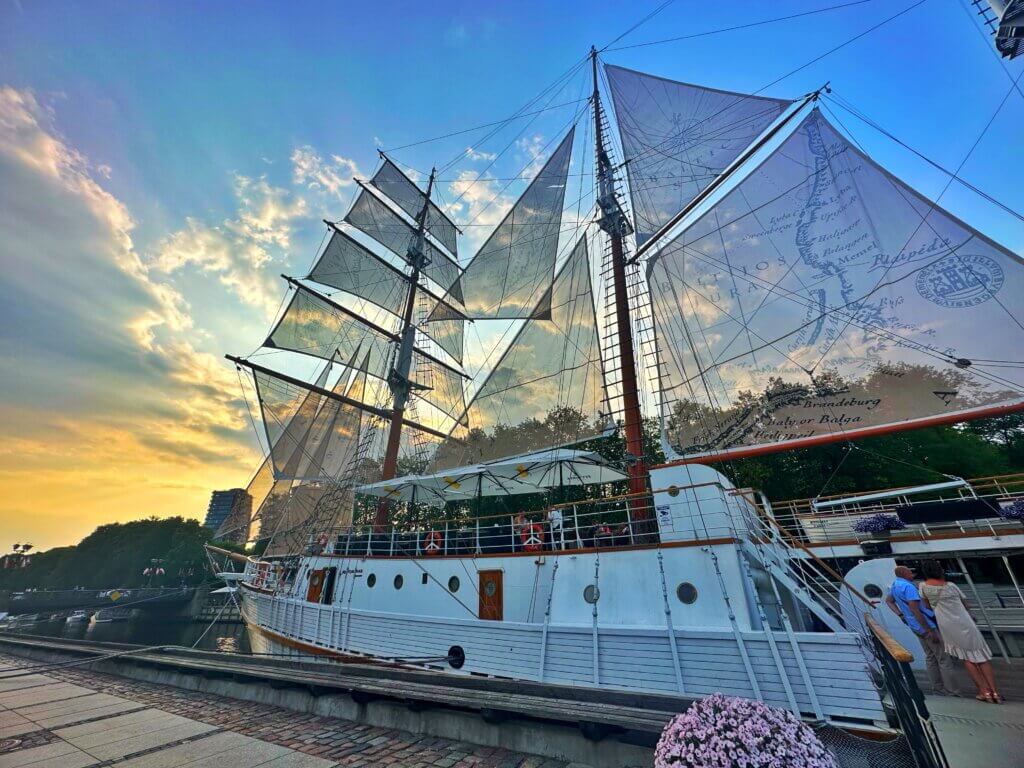
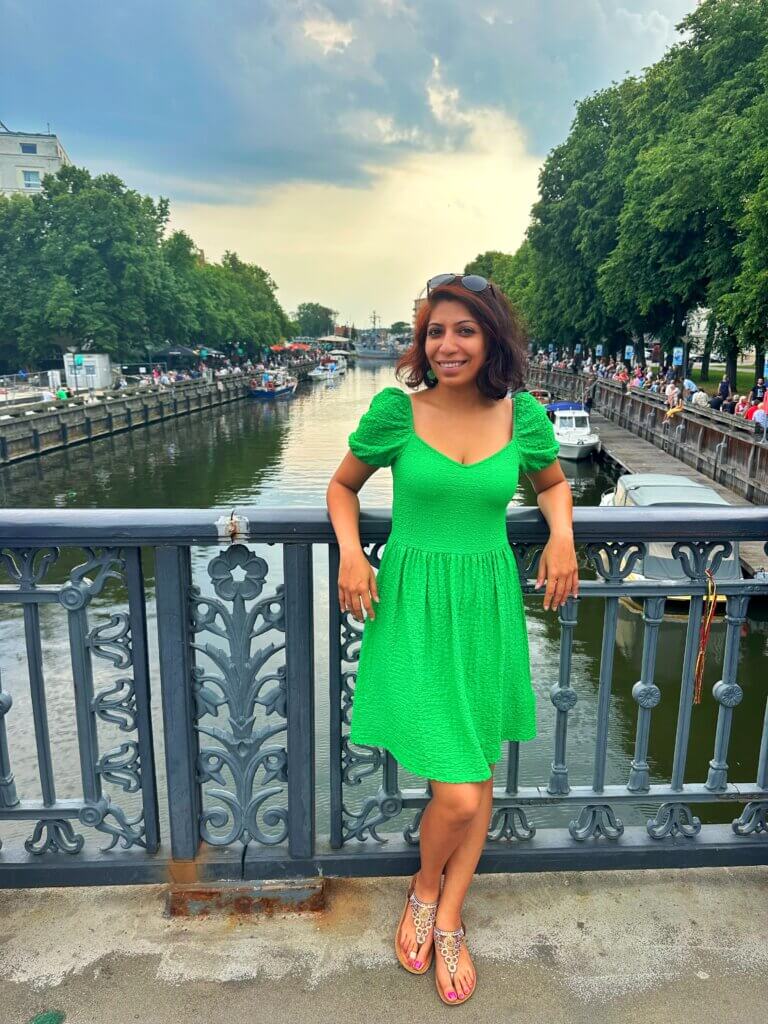
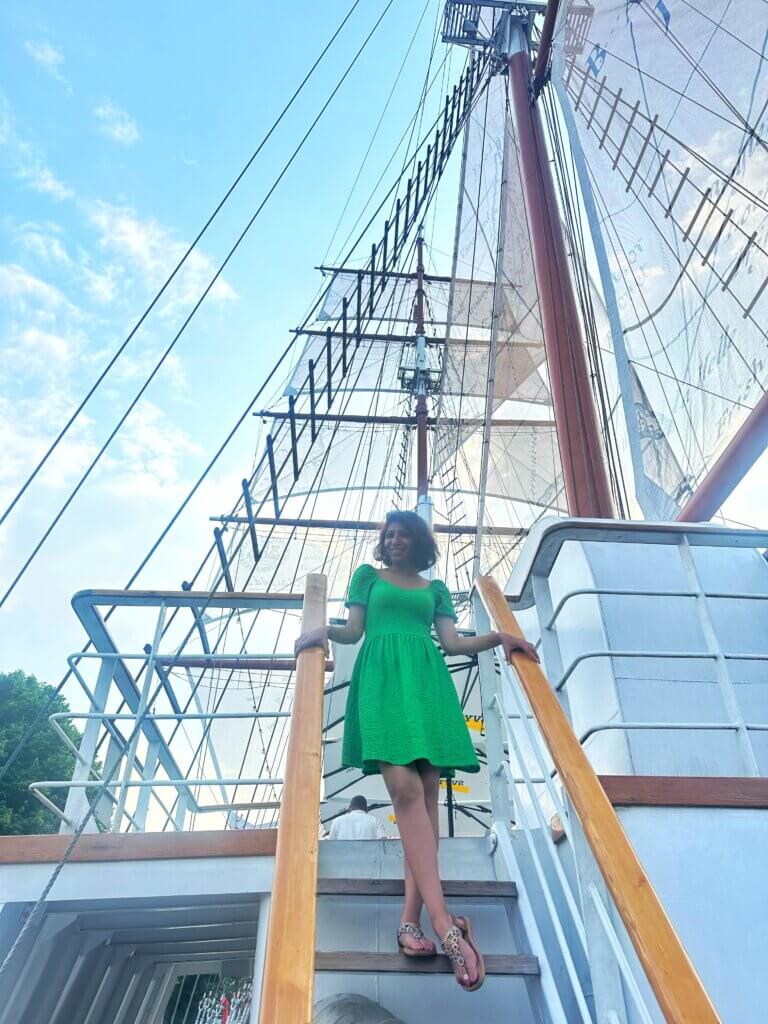

Recommend hotel to stay in Klaipeda Old Town: TILTŲ NAMAI Self Check-in Apartments Day 2: Day trip to Curonian Spit
Curonian Spit is the name of the thin strip of land surrounded by the ocean, located 10-min by a ferry boat from Klaipeda. During summer, many people head to the popular sandy beaches here but when we travelled during spring, it was still too cold to swim and it was raining on the day we arrived here, which made it impossible to sunbathe too. The ferry to Curonian Spit departs from Klaipėda Old Ferry Terminal, which is in the city center, close to the Old Town. In 10 min, you will reach across to a town called Smiltyne, from where you can board a direct bus (N1) to Nida, with a stop at Hill of Witches in a town called Juodkrantė. From Smiltyne to Juodkrantė, it is about 25 minutes.
The Hill of Witches is essentially an open-air art gallery featuring a collection of wooden sculptures and installations that depict characters from Lithuanian mythology, fairy tales, and legends. The sculptures are carved from oak and are the work of local artists. The sculptures are arranged along a thematic path, winding through a forested area. As you walk along the path, you will encounter various characters and scenes that are steeped in Lithuanian folklore and storytelling. Some sculptures depict witches, wizards, mythical creatures, and legendary figures, while others illustrate famous Lithuanian fairy tales and stories. This 2-hour journey through the forest, where you can choose to take anyone of the paths within the lush and peaceful forests of the Curonian Spit, adds to the magical and mysterious ambiance of the place.
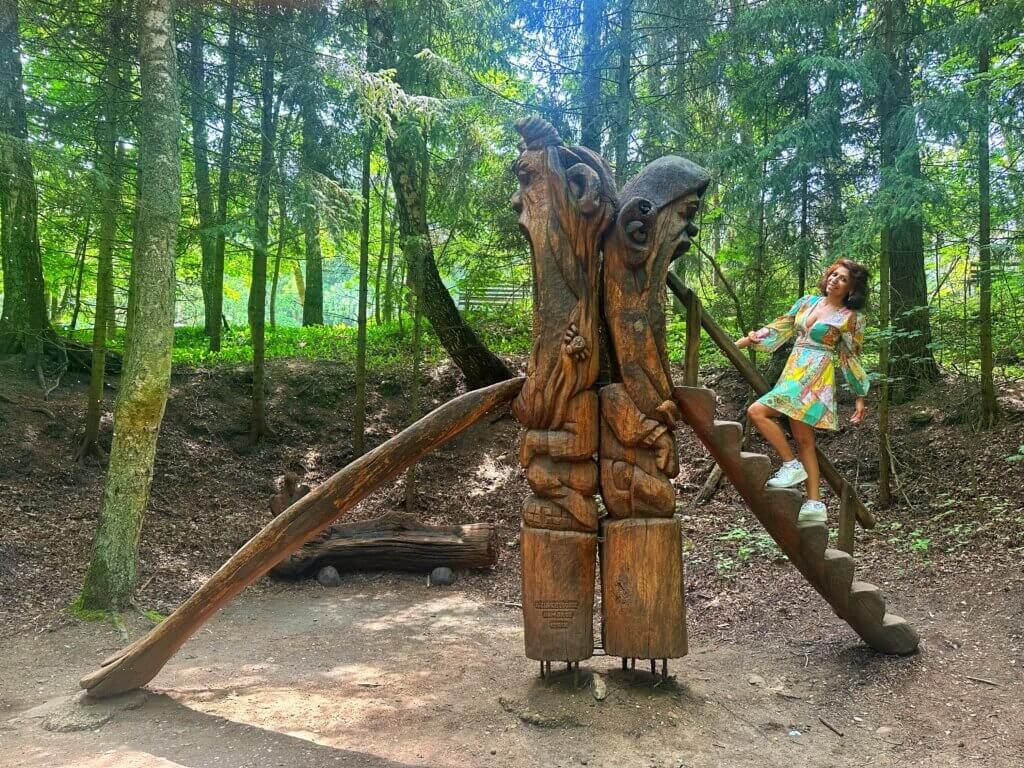
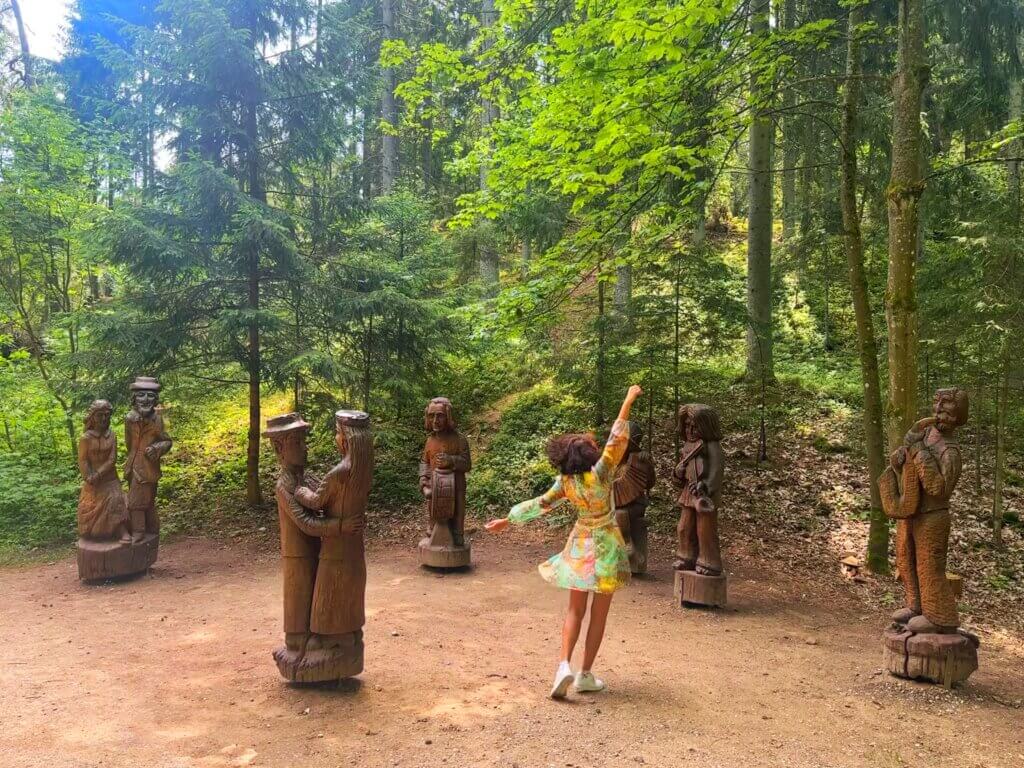
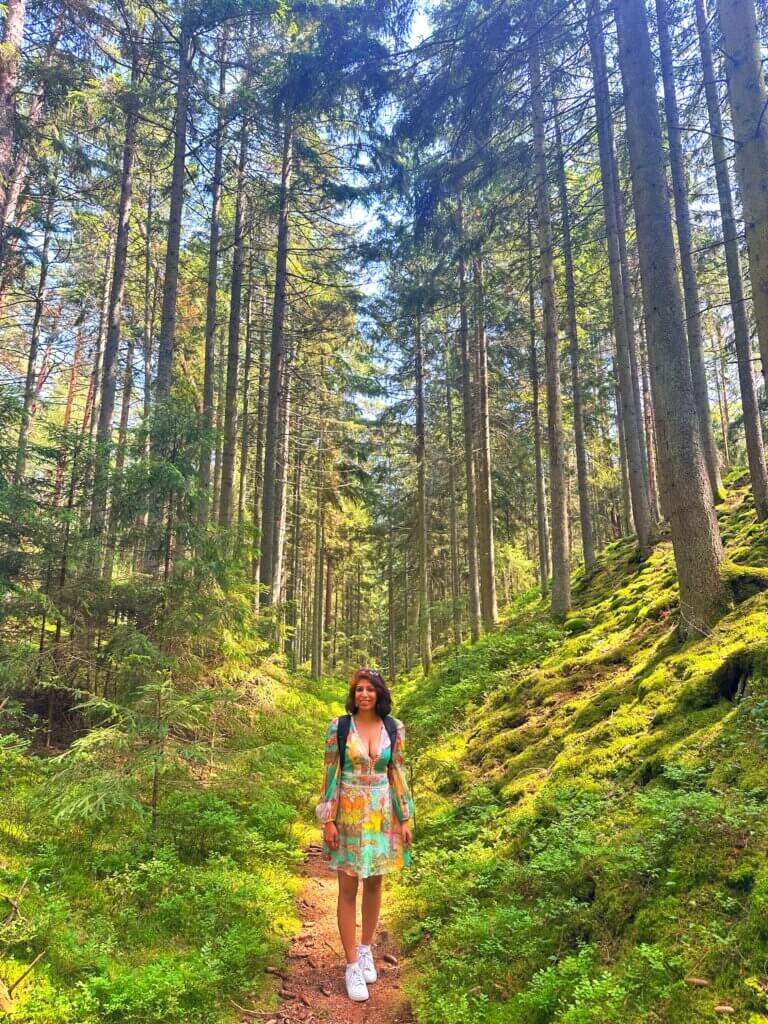
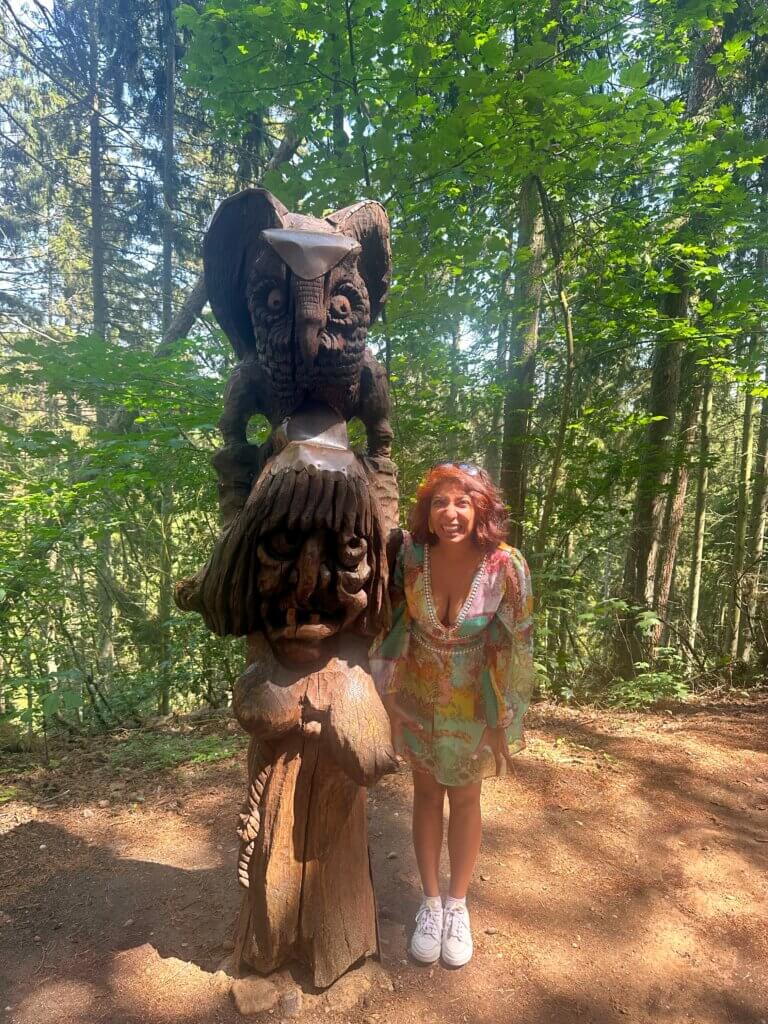
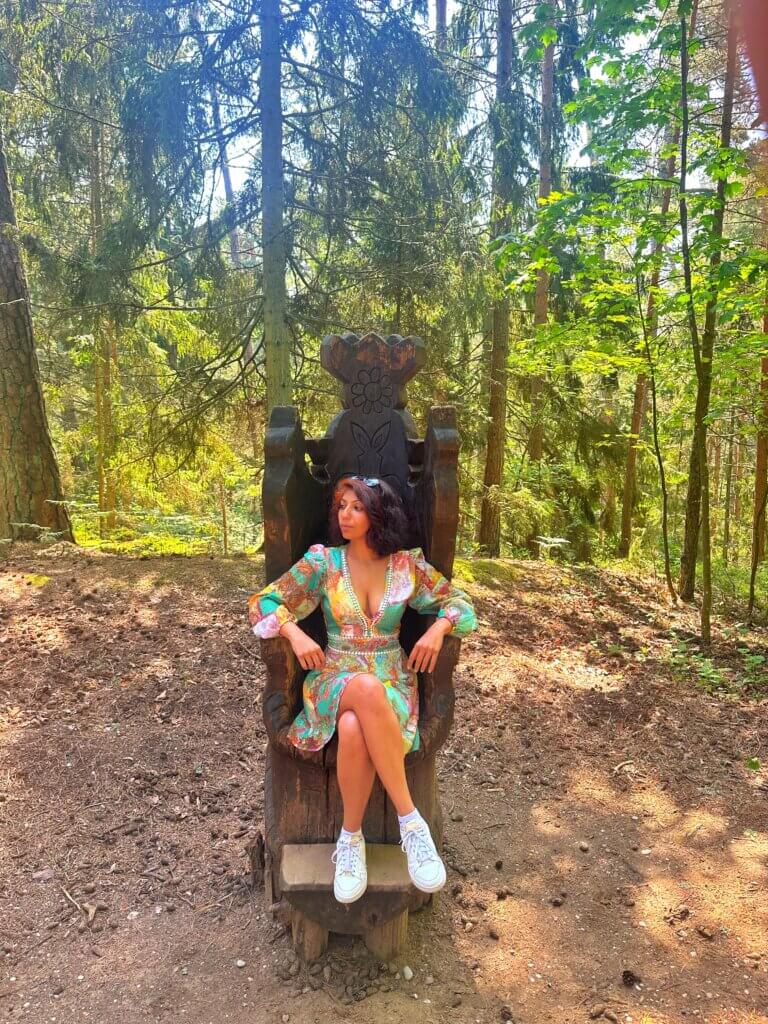
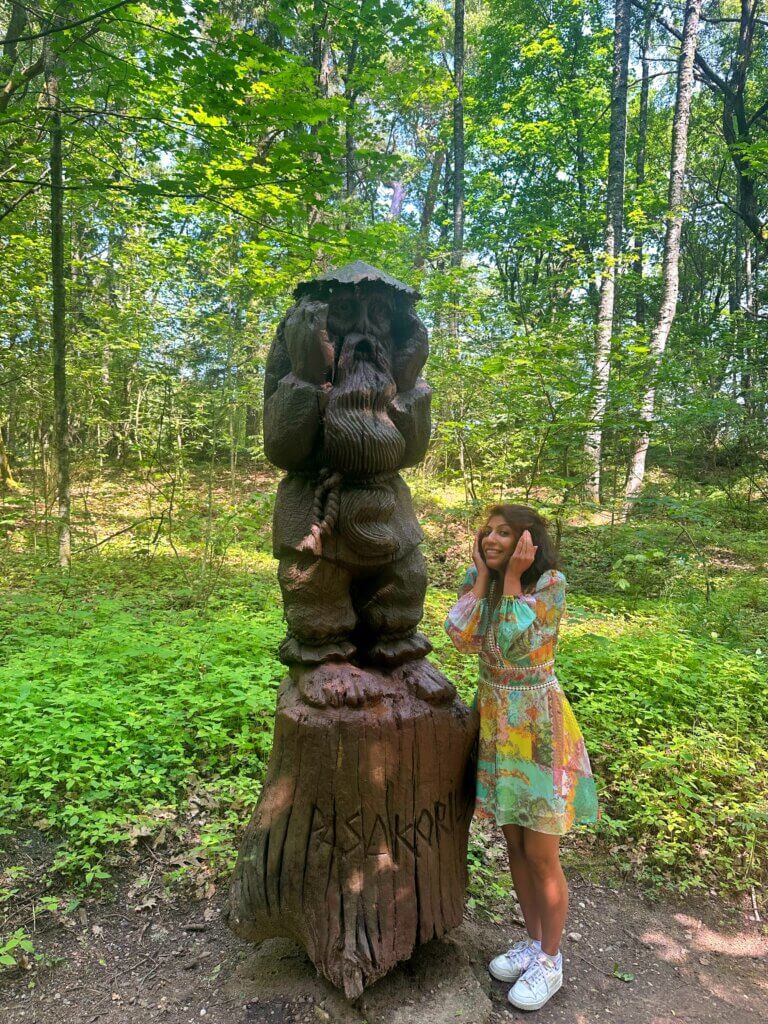
From here, you can board the same bus (N1) for another 20-min journey towards Nida. There are 3 keys places of interest in the largest town of Curonian Spit, which also shares a border with a Russian city called Kaliningrad. Parnidis Dune is one of the most iconic landmarks in Nida, offering panoramic views of the Curonian Lagoon, the Baltic Sea, and the surrounding landscapes. Climbing the dune and watching the sunset from its summit is a popular activity. Nida Art Colony is a creative hub where artists, writers, and researchers come together for residencies and art projects. Nida Beach is a popular spot for sunbathing, swimming, and enjoying the tranquil seaside atmosphere. You can have a nice meal either at the little hidden restaurant on the way to the beach or one of the restaurants located in the quiet Nida town center area. Curonian Spit’s unique blend of natural beauty, cultural heritage, and artistic spirit makes it a great destination to escape the hustle and bustle of urban life and immerse yourself in the tranquil nature. In the evening, return to Klaipeda Old Town via ferry from Smiltyne.

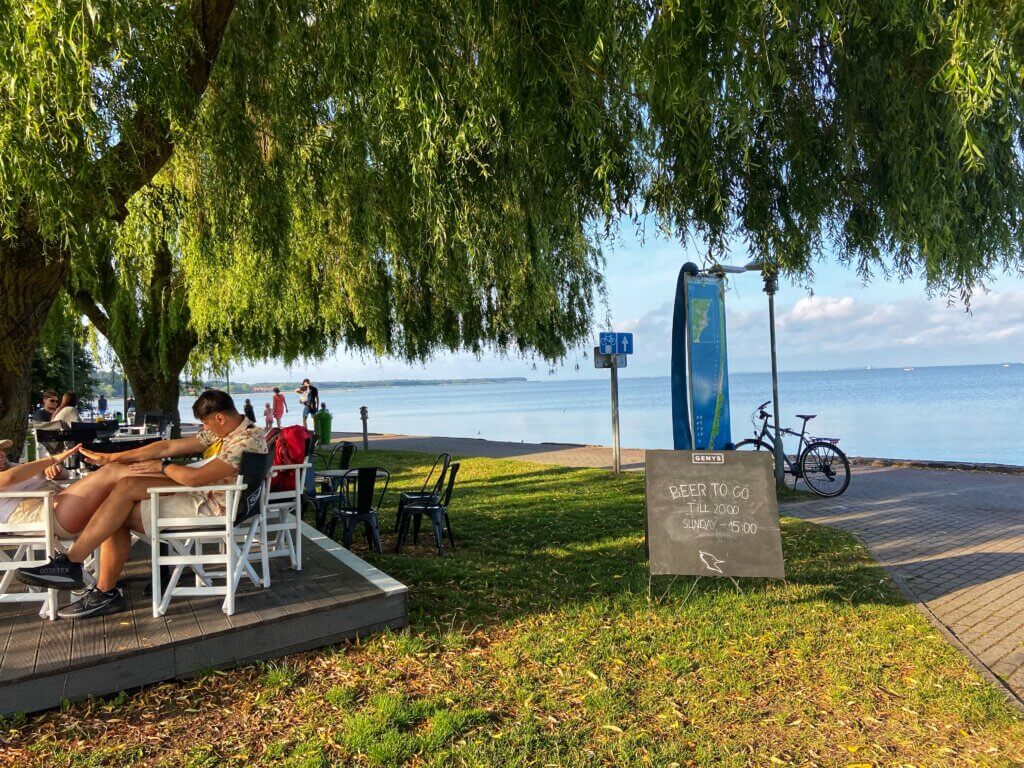
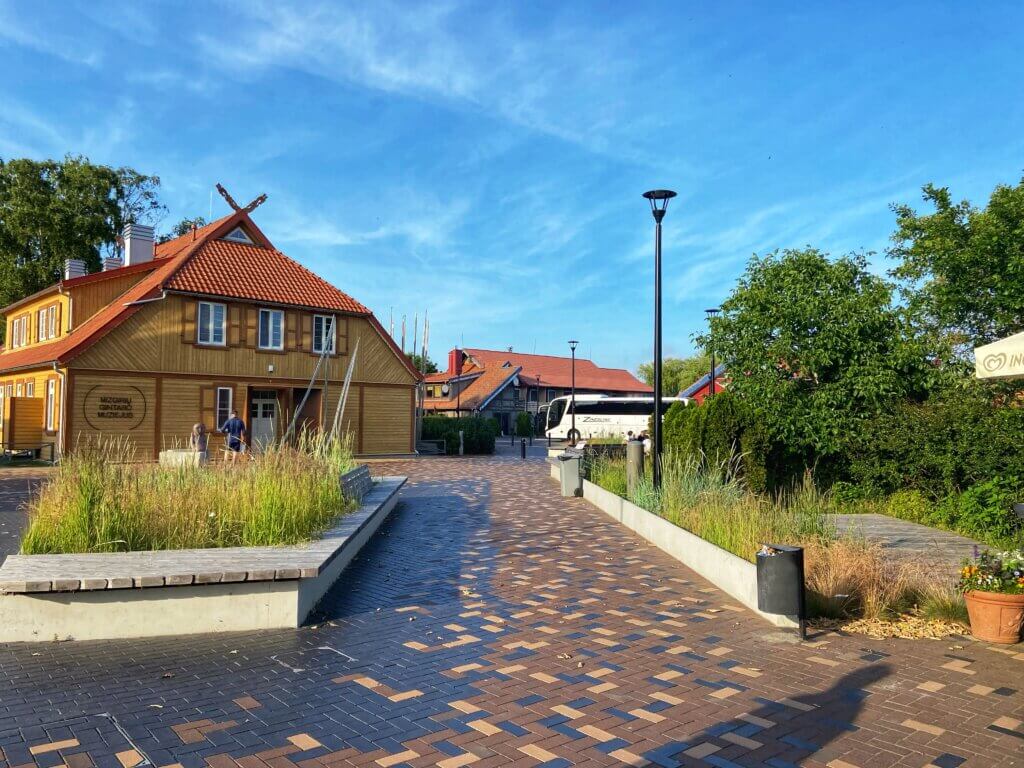
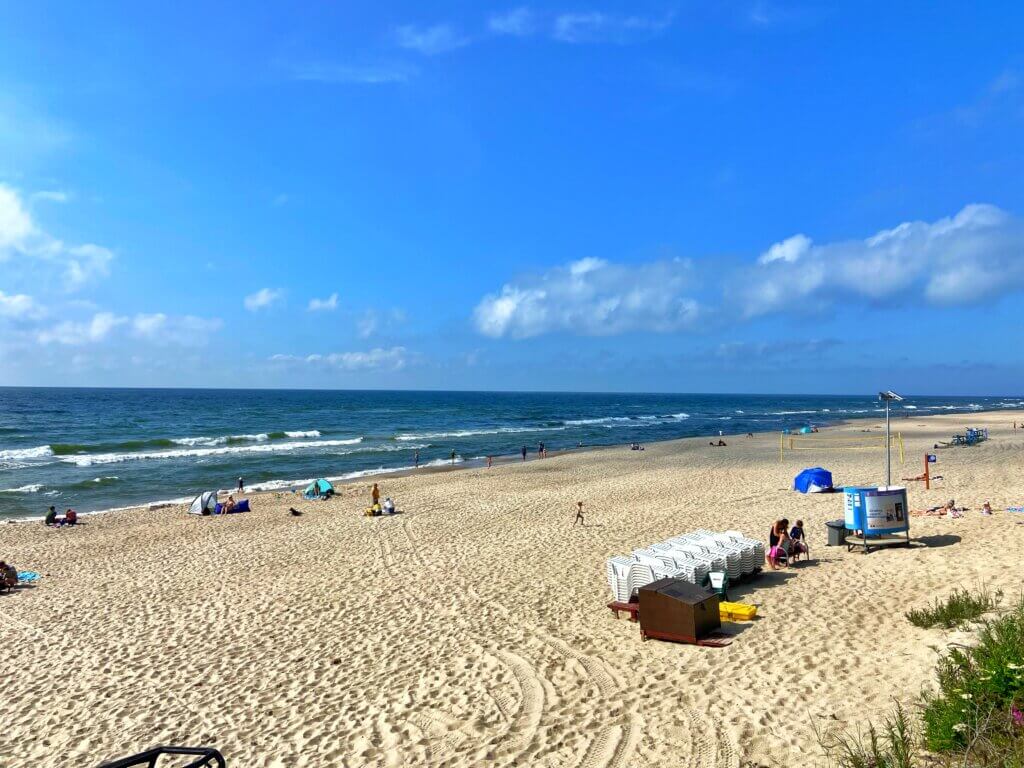
2 days in Vilnius, Lithuania
The last city of our trip to the Baltic States in 1 week was Vilnius. Almost a 4-hour journey by bus from Klaipeda, Vilnius, the capital city of Lithuania, is one of the oldest and most charming cities in Eastern Europe. It boasts a rich cultural heritage, a well-preserved historic center, and a vibrant atmosphere. Day 1: Vilnius Old Town
Vilnius' Old Town is a UNESCO World Heritage Site and one of the largest surviving medieval old towns in Europe. Typical to most of Europe, you will see narrow cobblestone streets, colorful buildings, and an array of architectural styles, including Gothic, Renaissance, Baroque, and Neoclassical. Start your exploration with The Gate of Dawn, one of the most important gates of the original city fortifications, renowned for its religious significance and the miraculous painting of the Virgin Mary enshrined within. The painting depicts the Virgin Mary with the Christ Child. It is believed to possess healing powers and has been associated with numerous miracles throughout history. The painting has attracted pilgrims and visitors seeking blessings and spiritual guidance.
The heart of Vilnius is Cathedral Square, where you can find Vilnius Cathedral, the bell tower, and the Gediminas' Tower. The square serves as a central meeting point and a venue for various events and festivals. Next to the Vilnius Cathedral, you will also find Palace of the Grand Dukes of Lithuania, a political, diplomatic, administrative, and cultural center of the Grand Duchy of Lithuania during the 15th – 17th centuries, and home to the National Museum today. The architecture you see today dates to the 21st century as the palace was unfortunately destroyed completely by multiple fires and invasions throughout its history.
I highly recommend taking a ticket to climb to the top of the Bell Tower. Also known as the Belfry of Vilnius Cathedral, it is a prominent architectural symbol of the city and an important historical monument. The Vilnius Bell Tower dates to the 13th century, making it one of the oldest surviving structures in Vilnius. It was originally constructed as part of the city's defensive fortifications. The bells go off every hour so if you’re in the observation deck during that time, it is quite exciting to see four massive bells swinging from one side to another as they mark the hour. Not only that, while the observation deck at the top is not open-air, it offers breathtaking views of the city's picturesque rooftops and historic landmarks through several windows.
From here, head to Gediminas’ Castle & Tower. Perched on a hill overlooking the Old Town, it is one of the iconic symbols of Vilnius. You can either walk to the stop or take a funicular that costs less than 1 Euro. The views from the top of the hill of Vilnius are stunning and you will find several vantage points from where you can enjoy these views. When you enter the castle, you will find several exhibitions at every floor of the tower, which will explain the history of Vilnius and it’s political and cultural significance. The most interesting story is of the Baltic Way, an event in 1989 when two million people from Estonia, Latvia and Lithuania joined hands, forming a human chain from Tallinn through Riga to Vilnius, spanning 675 kilometres, as a form of peaceful protest against the illegal Soviet occupation.
From here, walk to Three Crosses Hill, a prominent historical and cultural landmark that dates back to the 17th century. It is said that three wooden crosses were erected on the hill in memory of three Christian monks who were martyred at the site in the 14th century. The original wooden crosses were repeatedly destroyed over the centuries due to wars, fires, and weather. Each time, the crosses were reconstructed in honor of the monks and as symbols of Christian faith and resilience. The Three Crosses Hill is often considered a symbol of freedom and the resilience of the Lithuanian people. It serves as a reminder of Lithuania's struggle for independence and its determination to preserve its cultural and religious heritage. The hilltop location of the Three Crosses offers stunning panoramic views of Vilnius, including its historic Old Town, the Neris River, and the modern cityscape. Located in Kalnai Park, a beautiful green space that provides an escape from the urban hustle and bustle, it is also a popular spot to relax, have picnics, and enjoy the views.
On the opposite side of the Old Town, there are two interesting sites to visit, whether you find the time on your first day or the second one.
Recommended hotel to stay in Vilnius Old Town: Silvija House Day 2: Day trip to Trakai Castle
We took a bus from Vilnius to the town of Trakai. From here, there’s a 15 min walk to the Island Castle, a stunning medieval fortress which is one of the most iconic and well-preserved castles in the country. As you walk, you will see several parks next to the lake on both sides of the road, as well as cafes overlooking the lake. On reaching the island, you will find a very lively scene on the lakeshore before crossing the wooden footbridge over to the castle.
Trakai Castle was built in the 14th century by the Grand Duke of Lithuania, Kęstutis, as a defensive fortress and a residence for the Lithuanian rulers. It served as an important center of political and military power during the time of the Grand Duchy of Lithuania. Trakai Castle is an impressive example of Gothic architecture, with its red brick walls, defensive towers, and crenelated battlements. The castle underwent several reconstructions over the centuries, with some elements reflecting Renaissance and Baroque influences. Today, Trakai Castle serves as a museum, offering visitors insights into the history of Lithuania and the life of its rulers during the medieval period. The museum displays various artifacts, exhibits, and historical documents.
The castle's island location offers breathtaking views of Lake Galvė and the surrounding natural landscape. The picturesque setting makes it a popular spot for photography and enjoying the serene atmosphere. We loved taking a 45-min boat ride on the lake which gave us excellent views of the castle from different angles. Thereafter, you can enjoy a drink & meal at one of the restaurants overlooking the island castle.
This is a very relaxed day trip from Vilnius where you can choose to spend a day just sitting across the lake, enjoying a stroll through nature & just soaking in the tranquil environment.
In the evening, return to Vilnius.
The post How to explore the Baltic States in a week appeared first on Hopping Feet.



